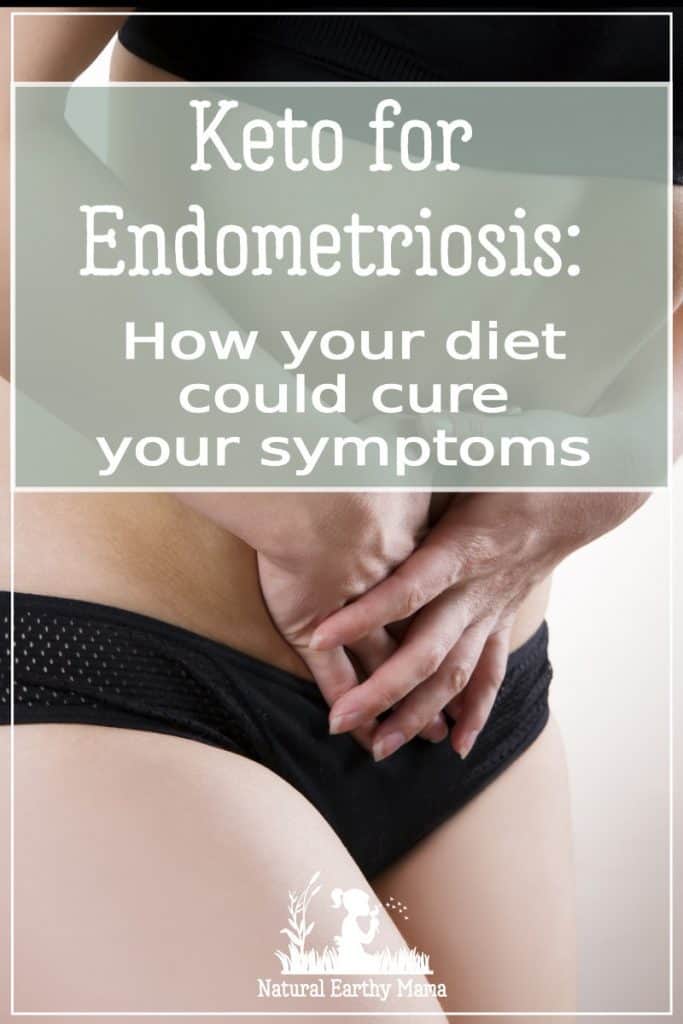 Endometriosis is a painful and frustrating condition, that until recently, we have known very little about. Treating endometriosis has been fairly hit and miss, but one thing that has been shown time and time again to help naturally reduce endometriosis symptoms is the keto diet.
Endometriosis is a painful and frustrating condition, that until recently, we have known very little about. Treating endometriosis has been fairly hit and miss, but one thing that has been shown time and time again to help naturally reduce endometriosis symptoms is the keto diet.
Using keto to treat endometriosis is yet to become mainstream, but there is a growing body of evidence that it works!
Please read: This information is provided for educational purposes only and is not intended to treat, diagnose or prevent any disease. We encourage you to make your own health care decisions in partnership with a qualified health care professional.
This post contains affiliate links, this means at no extra cost to you, we make a commission from sales. Please read
our Disclosure Statement
What is Endometriosis?
Endometriosis is where the types of cells that make up your uterine lining, end up growing in other places as well. This means that those cells also go through the monthly hormone induced changes, and they will bleed and shed every time the woman gets her period. This causes pain, scar tissue, and heavy clotted periods. It can also cause infertility.
The most common site of endo is the ovaries (causing a type of ovarian cyst called endometrioma or chocolate cyst). Endometriosis also occurs on the fallopian tubes, pelvic ligaments, and on the outside of the uterus, bowel, bladder even the lungs and brain have been documented as affected in some!
For more information about what exactly endometriosis is, read our ultimate guide.
Symptoms of endometriosis can start as soon as a girl gets her first period. However the symptoms are not always noticeable early on, and they can worsen as she gets older.
Any woman in her reproductive years can develop endometriosis, and the disease seems to affect women of all ethnicities and socioeconomic backgrounds the same.
Endometriosis symptoms include:
- Painful cramps
- Longer periods/heavy menstrual flow
- Pain during sex
- Chronic fatigue
- Nausea and/or vomiting
- Extreme hormonal aches outside of the uterus – headaches etc
- Urination and bowel problems
- Infertility: 30-40% of women who are afflicted with endometriosis have difficulty with fertility, according to the Endometriosis Foundation of America.
What causes Endometriosis?
There is no definitive explanation for why and how endometrial tissue forms outside of the uterus. However there is a growing body of evidence to suggest that is it actually an autoimmune condition (1,2)
Autoimmune conditions usually rely on a trigger to start the body to start attacking its own cells. In endometriosis, it appears that it is related to high levels of estrogen (3).
Risk factors also include genetics and exposure to toxins such as pesticides and dioxins (4).
Research has shown a significant connection between endometriosis and exposure to dioxins. Dioxins are a byproduct of the manufacturing process of bleached paper products. In the study conducted by the Endometriosis Association, 79% of rhesus monkeys that were exposed to dioxin developed endometriosis as a result (6).
Dioxin is very common, it is in coffee filters and menstrual products to start with. The EPA states that 40% to 70% of dioxins found in bleached coffee filters will be transferred into your coffee and thus, directly digested. This is why I recommend a reusable coffee filter, fabric pads and menstrual cups!
A woman’s microbiome (good bacteria in her gut and on her skin) also plays a role in developing or preventing endo from developing (5), so keep up those probiotics and fermented foods!
What makes Endometriosis worse?
Endometriosis is made worse when a women is in a state of high inflammation, high estrogen, or a highly toxic environment. Simply getting older can make it worse as well.
Treatment for Endometriosis
Modern medicine has no medical cure for endo, most solutions involve lowering the estrogen levels in the blood with birth control, and removing endometriosis lesions if they are causing trouble (6).
How does Keto help Endometriosis?
The ketogenic diet, aka keto is one of the most anti inflammatory diets around, and when it is combined with powerful hormone regulation, you are on to a winner for treating endometriosis.
What is the keto diet?
The ketogenic diet is high fat (75% or more), moderate protein (about 20%) and low in carbohydrates (5% or less). The keto diet cuts out all grains, grain oils, sugars, and most carbohydrates including most fructose.
The percentages are worked out by calories, not by weight or volume. So 75% of your calories are to come from fat, not ‘75% of your plate is to be covered in fat’, and not ‘75% of the weight of your meal has to be fat’.
Fat has 9 calories per gram, and carbohydrates and protein have 4 calories per gram, making fat a much more dense form of energy. Also fat is in foods like meat, dairy, nuts, eggs and avocados, this all counts towards that 75%, it adds up faster than you might think.
The keto diet has been around for a very long time, in fact, it is how your body was designed to run!
Keto gets its name from the keytones that your body creates when it is breaking down fat and using it for energy. It is a common misconception that your body needs carbohydrates to function. This is simply not accurate. Your brain can run off of two substances – glucose and keytones. It doesn’t mind at all which it uses.
For more information about the ketogenic diet read: What is the ketogenic diet and Won’t all this fat give me a heart attack?
How can the Keto Diet help with Endometriosis?
1. Removing inflammatory foods
Grains, industrial oils (corn, soy, canola), gluten, legumes and sugar (especially fructose) are all highly inflammatory. In the keto diet, we eliminate all of these.
The grains contain anti nutrients, designed to protect the seed, but that cause inflammation in humans and animals that eat them. Also many crops are GMO and sprayed routinely with pesticides and herbicides.
Fructose is highly inflammatory and is the leading cause of non-alcoholic fatty liver disease. It is addictive, and has devastating effects in the human body, and it is responsible for up to 70 conditions (7,8).
What is inflammation? It is swelling and pain. There is an increase of blood flow, and more fluids in the area, as well as an increase in immune cells, these all required the blood vessel walls to be very permeable and let these things flow back and forth easily between the inflamed area and the blood.
High levels of inflammation in the body causes an increase in gut permeability. This allows proteins to sneak in to the blood stream that shouldn’t be there. Then the body creates antibodies for these proteins, and you start to react to them. This then leads to both food allergies and autoimmune disorders.
Eliminating these inflammatory compounds can help to seal up your gut, and allow your body to heal.
2. Reducing excess estrogen levels
The keto diet will help you naturally reduce your excess estrogen levels, while at the same time help you easily lose any extra estrogen-producing fat that you have. It also removes most dietary sources of estrogen from your diet!
RELATED POST: High estrogen foods to avoid
3. Reducing excess insulin levels
You don’t have to be fat or have diabetes to have high insulin levels. Slim people can suffer from insulin resistance as much as fat people do. In fact, being over weight is a symptom of insulin resistance, not the other way around!
Excess insulin levels will raise both inflammation AND estrogen levels as I explain below:
How carbohydrates raise estrogen levels
Any carbohydrate that you eat will be converted in to glucose (sugar). EVERY ounce. I know you have been told that whole grains are OK, and that lower GI carbohydrates are the best thing ever. But it is simply not accurate.
Those carbs will be turned in to sugar. It makes no real difference whether it is all immediate, or spread out over a couple of hours. Each unit of carbohydrate will become a unit of sugar and will require a unit of insulin to move it around the body.
Your endocrine system (the thing that makes hormones like insulin and estrogen) perceives high blood sugar as a stressor. And it is. High levels of sugar in your blood can cause blindness, heart disease, nerve damage and poor circulation/gangrene.
Your adrenals glands respond to this sugar rush by sending out a lot of cortisol (the stress hormone) and adrenaline. This begins the hormonal havoc.
When you eat sugar (or any carb-based food that your body will convert to sugar) it stimulates your insulin response.
The only way the glucose can get into the cells in your body that need it, is with insulin. When you eat a lot of sugar or carbohydrates, and there’s a lot of glucose in your system, your body sends out lots of insulin to deal with this.
The glucose in your body enters the cells, but there’s excess insulin and glucose. Your body doesn’t need all that much glucose and cannot use it all, but it cannot be left floating in the blood stream.
Your cells are full up, so they start boarding up some of the insulin receptors so that no more sugar can get in, they are becoming resistant to the action of the insulin.
In response, your body has to keep making more and more insulin to bully the sugar out of the blood stream and crammed in to the cells.
This situation is called insulin resistance. If this process continues, eventually your body simply cannot make enough insulin to keep on top of the blood sugar levels, and the pancreas beta cells that make the insulin get burned out.
Taa-daa you have diabetes.
The effect of high insulin on estrogen levels
A continual ride of glucose and insulin spikes disrupts ovulation – preventing your hormones from triggering ovulation and the creation of progesterone as a result of ovulation.
This disrupted ovulation causes an hormonal imbalance – without ovulation you cannot produce progesterone, which leads to estrogen dominance.
Now the kicker with this is that estrogen is a fat storing hormone. It tells your body to store more fat.
AND GUESS WHAT?
Your fat cells in your body secrete estrogen.
The more sugar you eat, the more fat cells you create, the more estrogen they secrete so the more fat you will store and so on and so on…
This estrogen adds to the estrogen your endocrine system produces. Add in xenoestrogens (from chemicals like plastic and sprays on food) in our environment. You’re set up for estrogen dominance, progesterone deficiency, and hormonal imbalance.
This hormonal imbalance is a root cause of common female issues like PMS, cramps, irregular cycles, acne, along with PCOS, endometriosis and infertility issues.
Treating Endometriosis with the Keto Diet
The keto diet is a very effective tool in addressing the underlying causes of endometriosis, as well as reducing symptoms and in some cases removing all clinical signs of the condition.
To use keto to treat endometriosis, you should look in to following a ketogenic diet, and get some specific advice about reducing your own symptoms. You are welcome to join our free Facebook group – I am a certified Keto Coach and I am happy to help.
If you need inspiration about keto meals, check out the meal plans on Earth Larder.



